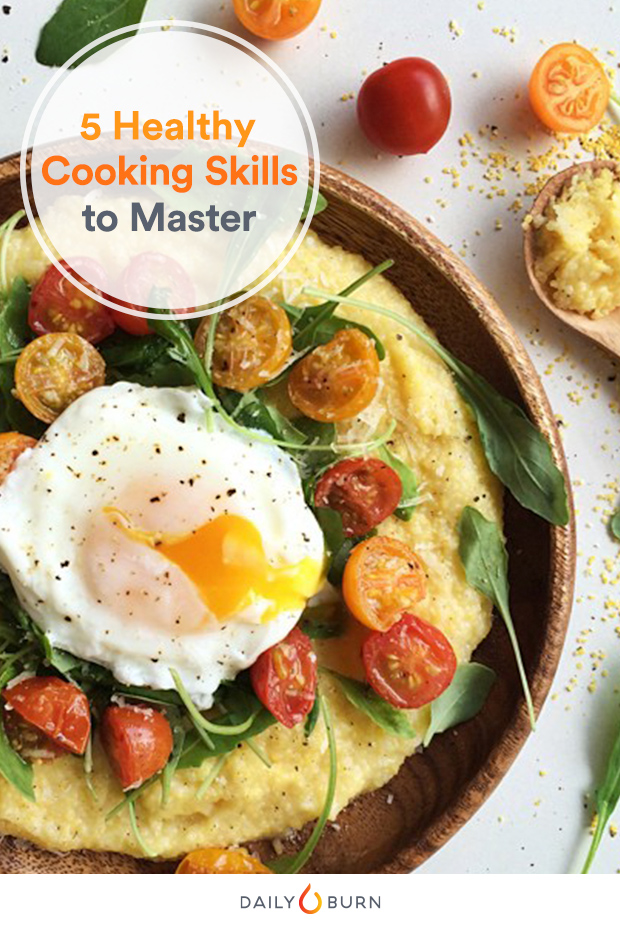
Research has shown that cooking at home helps us eat healthier and consume fewer calories, but that doesn’t mean we were all born with a spatula in hand. If your kitchen skills don’t yet resemble Gordon Ramsey’s, we’ve got the beginner-friendly tutorials you need to learn to cook healthy and delicious food every day. Poaching an egg — totally doable. And sautéing sans oil — easy as cake (well, you know what we mean). These healthy cooking techniques are yours for the taking.
RELATED: 4 Science-Baked Cooking Hacks from The Food Lab
5 Healthy Cooking Videos to Make Over Your Meals
Blanching
What it is: Blanching is the process of quickly cooking food in water or steam. From there, you can freeze ‘em to have veggies on hand long-term.
Why it’s healthy: According to the UGA’s National Center for Home Food Preservation, blanching “is a must for almost all vegetables to be frozen. It stops enzyme actions which can cause loss of flavor, color and texture.” In other words, if you want to preserve your favorite produce all year long or have an easy-to-prep veggie side dish in the freezer for a busy weeknight, blanching is key.
How to do it: Start with a pot of boiling water and a bowl of ice water at the ready. Toss your vegetables into the boiling water, and then pull them out after the recommended cook time and place them in the ice water. Lay your cooked veggies in a single layer on a sheet pan to flash freeze before bagging them in individual freezer bags. Video: The Kitchen Hour
Poaching Eggs
What it is: Poaching is one of the healthiest ways to enjoy eggs because it doesn’t require any fat (whether it’s oil or butter). Poaching involves submerging food in a liquid, but it’s different from boiling because you’re using “moist heat.”
Why it’s healthy: Whole eggs are a healthy choice on their own, and when combined with a cooking method that adds no extra fat, they’re far more sinless than that delicious, creamy yolk might suggest. (Worried about runny eggs being unsafe to eat? Salmonella is killed off at the same temperature that egg whites “set,” so if your whites are cooked, you should be fine. You can also opt for pasteurized eggs to avoid this issue entirely.)
How to do it: Create a “water tornado” in a pot of boiling water with a slotted spoon. Drop a cracked egg into the spinning vortex, so that it forms into a nicely rounded shape. Some people like to crack an egg into a separate bowl and then pour it into the water. Use your spoon to gently wrap any straggly bits onto the cooking egg. Remove it from the water with the slotted spoon after 3-6 minutes. You can also get a written version of how to poach an egg at Hilah Cooking’s blog. Video: Hilah Cooking
RELATED: 8 Quick and Easy Egg Sandwich Recipes
Steaming
What it is: Forget the stereotype that steamed veggies are the uber-bland basis for all boring weight loss diets. You can steam just about anything — not just veggies — and have a delicious and healthy meal, to boot.
Why it’s healthy: Steaming is the best cooking method for retaining the vitamins and other good-for-you compounds in fresh vegetables, according to research. Since you flavor your food after cooking rather than before, you can more carefully control the amount of fat, sugar and salt you consume.
How to do it: Place a steamer basket over a pot of boiling water, add your items to be cooked and cover tightly. Remove after the recommended cook time and season to taste. Video: Clean & Delicious
RELATED: 9 Kitchen Tools Every Home Cook Needs
Grilling Meat
What it is: Grilling is a great cooking technique to practice year-round. It yields beautiful caramelization on your meats (or anything else).
Why it’s healthy: Grilling draws out the excess fat and oil from meat and helps veggies retain their nutrients. It’s important to know that grilling meats (but not veggies), can release some cancer-causing chemicals. However, there are a lot of ways to reduce the carcinogens and lower your risk of illness, so you can have your steak and eat it, too.
How to do it: Prep your meat by trimming the fat, drying, oiling and then salting. Prolonged, direct heat makes meat tough and dry, so flipping frequently is the key to juicy meat. Leave the cut just long enough on each side to develop grill marks. Once you’ve got your grill marks, lower the heat, move the cut away from the heat source, and finish cooking. Video: Helen’s Kitchen
Sautéing With and Without Oil
What it is: Sautéing is an essential cooking skill and simply means to cook for a short amount of time over high heat, usually in oil.
Why it’s healthy: Traditional sautéing already uses significantly less fat than, say, frying. While fat can definitely be healthy, cooking in fat often makes it difficult to tell just how much fat you actually consume. Plus, with the help of the video above, you can even sauté without any extra fat at all.
How to do it: Your pan and oil should already be hot before you add the food you’re cooking. This is key to getting a nice crispy brown on the outside. Also important: Don’t overcrowd your pan, which can leave food soggy instead of sautéed. Video: Kris Carr
